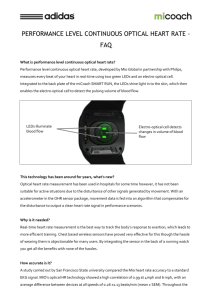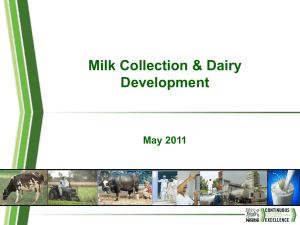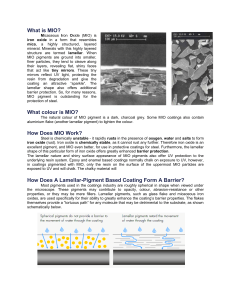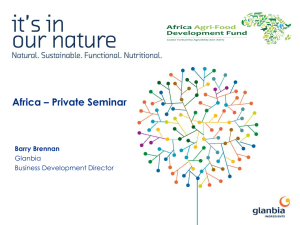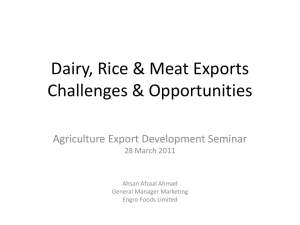Présentation du groupe GIRA
advertisement
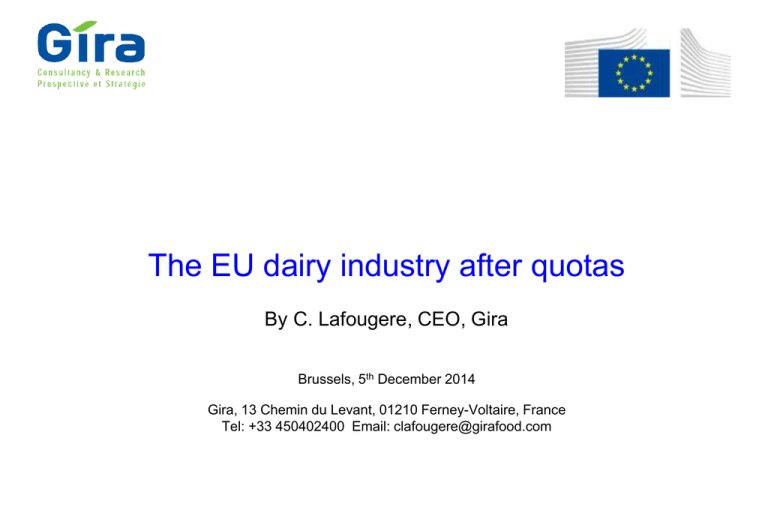
The EU dairy industry after quotas By C. Lafougere, CEO, Gira Brussels, 5th December 2014 Gira, 13 Chemin du Levant, 01210 Ferney-Voltaire, France Tel: +33 450402400 Email: clafougere@girafood.com What the future may hold Much more milk, and mainly from Europe World milk production: +97 mio t in 2013 to 2018 The EU, India & USA are the largest producers Milk Production growth in million tons, 2013 through 2018 +50.7 * +12.4 TR +4.7 +7.2 -0.16 +6.7 -0.43 +4.7 +1 +0.7 +2.8 +10 mio t 2013-18 volume change (mio tons) Not covered The EU will be the main dairy pool for the world * including buffalo milk Source: GDC 2014 Milk collection: our forecasts for 2018 The optimistic scenario EU TOP 8: +13.8 mio tons EU 27: +14.1 mio tons (2013/2018) +1.9% growth per year Ireland (+5.4% p.a. 2013/2018) The UK (+2.3%) Denmark + 0.9 mio ton Ireland + 1.7 mio tons The UK + 1.7 mio tons France (+2.2%) The Netherlands + 2.6 mio tons Germany + 2.8 mio tons France + 2.8 mio tons Poland + 1.0 mio tons The Netherlands (+3.9%) Germany (+1.8%) Poland (+1.9%) Italy + 0.4 mio tons Denmark: (+3.3%) 4 EU dairies are optimistic – but not reckless… Almost all of Gira’s interviewees were quite positive about the future of the EU industry and are investing in order to handle extra milk as a consequence. But a closer look at the proposed investments shows certain strategic themes emerging. Just on the basis of the limited information in the figure above: Around a third of total investment is for the highly targeted, essentially “non-commodity” Infant Formula market, and over a half of this is for one major new plant for FrieslandCampina. Over a quarter of the total investment is for enhanced whey processing. With few investment going into supplementary cheese processing, this could indicate that the intention is as much to better valorise the whey from existing cheese production as to handle more milk, And since a further € 120 million of planned investment is for one single lactose plant, … then we are probably left with only around a third of the investment listed above that is destined for commodity powders production (of which maybe 40% in Ireland alone). EU dairies thus appear to be limiting their exposure to over-investment in post-quota milk. Moreover, we are told that a significant (but unspecified) part of the investment in basic powder drying is to replace and expand existing capacity. 5 Infant formula and nutraceuticals will be the main drivers of whey globally Consumption & growth potential of the main user-segments of dry whey products 6 In the future, the key challenge will be for EU coops… How to handle more milk and still continue to add enough value, mainly on world markets? 7 The Top 10 dairy coops in the EU, 2013 Total turnover: € 40.5 bios, of which 59% is done internationally Internationalisation is now the main challenge for EU dairy coops There are two main categories of coops in Europe: The ones with over 50% of their sales outside their home market: only FrieslandCampina, Arla and Glanbia. They aim to become mega-coops, and they work on 3 main axes: • Development on growing export markets • Adding value through branding • Developing their activity on technical ingredients and infant formula And the smaller coops, whose presence on international markets still needs to be developed if they are to be competitive for the future 8 The Top 10 dairy coops in Europe They processed 45.7 bios litres in 2013, of which only 22% outside their home market 9 Conclusions 10 Conclusions The EU will play an increasingly important role in world trade because it is the most promising exporting dairy region in terms of growth potential and quality guarantees • Perhaps along with the USA But not forgetting that the EU’s domestic market itself also urgently needs stimulating and valorising. Companies will have to handle more milk in the near future. For some of them there is an urgent need to adapt their strategies to create more value with this extra milk All dairies will have no choice but to add value wherever possible, by: • Ensuring export outlets in solvent markets – and selling directly to end-users • Acquiring manufacturing subsidiaries abroad – with their own local milk supply • Tailoring products to specific market and client needs • Selling increasingly « technical » commodities • Offering NPD to clients in: product formulation, packaging, plant management solutions, etc. 11 Thank you

